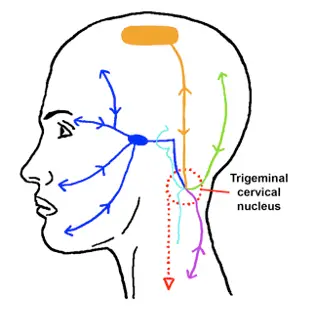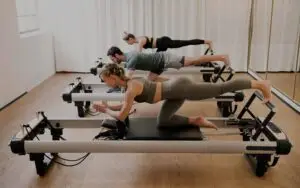So why do I get them?
We commonly believe that headaches and migraines are simply triggered by stress, hormonal imbalances, or a lack of water, but in reality, there is a much deeper and more accurate reason for them.
Fortunately, current research is now revealing that headaches and migraines occur due to a sensitive nervous system, specifically the Trigeminocervical Nucleus. In addition, recent research has revealed that one of the most powerful causes of this nervous system sensitivity is a dysfunction in the upper neck (Cervical 0-3).[5]
Due to this sensitivity, a normal stimulus is registered as a trigger for a headache or migraine attack. The trigeminal nerve, which supplies sensory information to the head, face, jaw and teeth then picks up this amplified and irritable information. Which then itself becomes inflamed and irritated as well and registers pain being present in the face, head, jaw – wallah! a headache! [6] So, the real cause of headaches and migraines is actually a sensitised nervous system.[7]


So now we know how headaches and migraines occur, the next 5 tips will be quite easy to understand and implement.
How can it be relieved?
1. CALM DOWN THE BRAINSTEM SENSITIVITY (NEUROMODULATION)!
This can be done to a certain extent by yourself as a headache/migraine sufferer! Things such as, ice, voltaren gel or fisiocrem (anti-inflammatory creams) can aid in calming down the nervous system irritability. This will help to an extent. But a physiotherapist helps calm down the sensitivity even further. We correct the upper cervical (C0-3) dysfunction, calming down the nervous system sensitivity significantly. Modalities such as, laser therapy and acupuncture (which we can provide) can also help in this desensitising process.
2. GET THAT STRENGTH BACK!
The stronger your back and neck muscles are, the less force and pressure is placed through the joints[8]. Strengthening the back and neck also helps in correcting your posture. Fun fact – the average head weighs approximately 5kg. When you hunch forward just even by 3-6cm, you’re placing up to 4x the amount of weight through your neck and muscles![9] That’s 20kg! Sit and stand tall and experience what a wonder of good that would do!
3. INCREASING MOBILITY!
Research suggests that increased thoracic (mid-back) stiffness places more pressure and force through the neck, which in-turn irritates the neck as well as increase neck dysfunction.[10] Thoracic stiffness occurs with prolonged and sustained positions, usually present with desk-workers sitting at the desk all day. A foam roller and simple thoracic exercises help to increase thoracic mobility and reduce stiffness. By increasing movement in the thoracic spine, you are placing less force and pressure through the neck. It is important for your physiotherapist to guide you with appropriate mobility exercises, to avoid aggravating your neck and back while still achieving mobility gains.
4. MOVE FREQUENTLY!
Your spine and other joints. While at work, drink from a cup of water rather than a water bottle. This will encourage you to move more frequently as you refill your cup throughout the day. You can have the printer further away from your computer which means walking to the printer. Simple changes like these can really make a difference to your spine health.
5. MANAGE STRESS
During stressful times, do things that that help you destress! Whatever the activity may be, do it during times of high stress. It could be a cycle of deep breaths; in through the nose and out through the mouth. It could be going for walks, the gym, painting. Whatever it may be, make sure you do these activities regularly to help you relax.
These 5 tips will help you take hold of your life again. Why live with pain?
If you have any questions, please don’t hesitate to contact us at Agape Physiotherapy.





